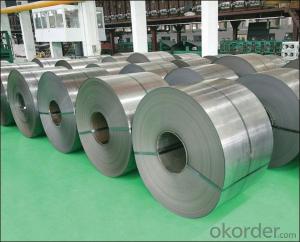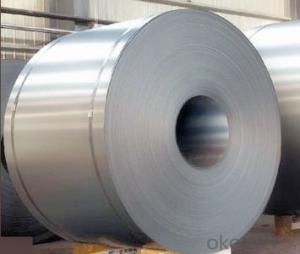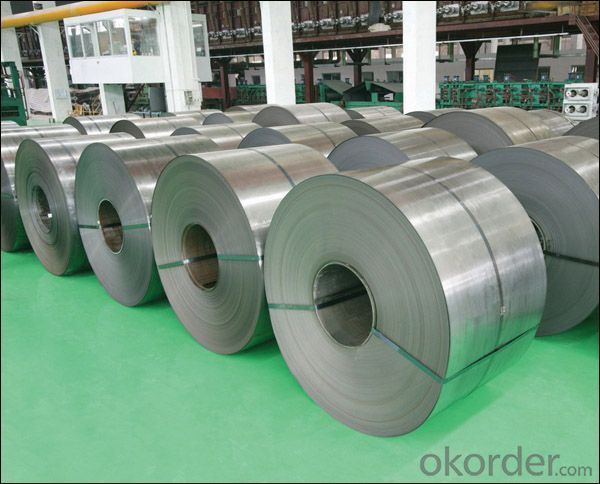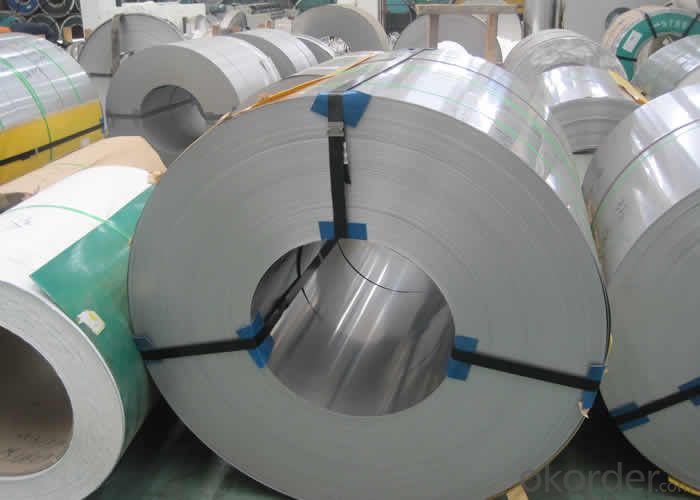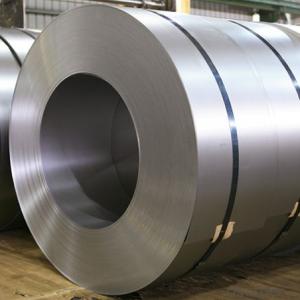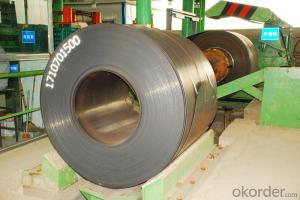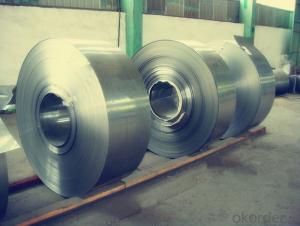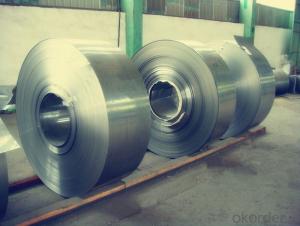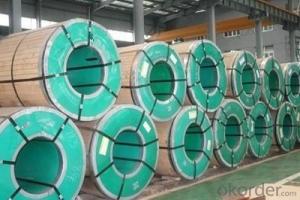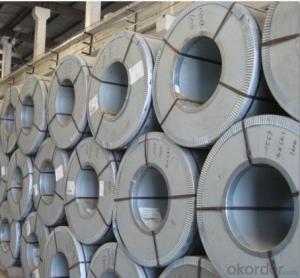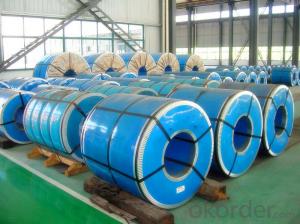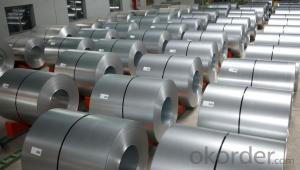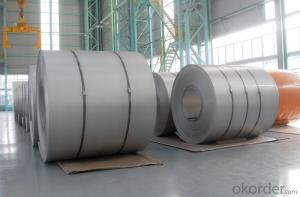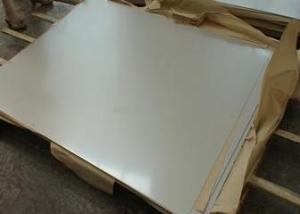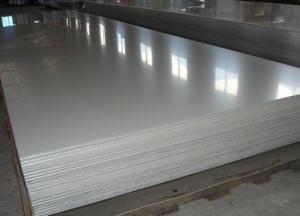Hot Rolled Stainless Steel Coil 201 No.1 Finish Narrow Strip
OKorder Service Pledge
OKorder Financial Service
You Might Also Like
Hot Rolled Stainless Steel Coil 201 Narrow Strip No.1 Finish
Grade: | 200 Series | Standard: | JIS,AISI,ASTM,GB,DIN | Thickness: | 2.5/3.0/4.0mm |
Width: | 485/510/550/610/1010/1240mm | Place of Origin: | Shanghai China (Mainland) | Brand Name: | CNBM |
Model Number: | 201 | Technique: | Hot Rolled | Application: | Industrial tubes/kitchen/bath |
Certification: | ISO | THK: | 2.5/3.0/4.0mm | Face: | No.1 |
Usage: | tubes/kitchen/bath | Origin: | CHINA | ||
Packaging Detail: For customer's requirement
Delivery Detail:10-30days
201 Hot Rolled Stainless Steel Coil Specifications
THK:2.3/2.5/3.0/4.0mm
Width:485/510/550/610/1010/1240mm
Face:No.1
201 Hot rolled stainless steel Coil Application
Stainless steel is a production which not easy rust,acid resistance and corrosion resistance,so it is widely
used in light industry,heavy industry,daily necessities and the decoration industry.
201 hot rolled stainless steel coil, use to produce cold rolled stainless steel coil and stainless steel tube, pipe.
201 Hot Stainless Steel Coil Chemical Composition(WT%)
(C):≤0.15, (Si):≤0.75, (Mn):5.5~7.50, (Cr):16.0~18.0, (N):≤0.25, (Ni):3.50~5.50, (P):≤0.060, (S):≤0.030
201 Hot Rolled Stainless Steel Coil
Strength Of Extension:100,000 To 180,000 Psi;
Yield Strength:50,000 To 150,000 Psi
Elongation :55 To 60%;
Modulus Of Elasticity:29,000,000 Psi;
Density :.280lbs/Cubic Inch(7.93g/Cm3)
- Q: Can stainless steel strips be used for architectural signage?
- Yes, stainless steel strips can be used for architectural signage. Stainless steel is a durable and versatile material that is often used in architectural applications due to its strength and resistance to corrosion. It can be easily formed into various shapes and sizes, making it suitable for creating signage with different designs and dimensions. Additionally, stainless steel is known for its aesthetic appeal, with its polished finish providing a sleek and modern look. This makes it a popular choice for architectural signage, as it can enhance the overall appearance of a building or space. Furthermore, stainless steel is a low-maintenance material that can withstand harsh weather conditions, ensuring that the signage remains in good condition for an extended period. Overall, stainless steel strips are a reliable and visually appealing option for architectural signage.
- Q: Can stainless steel strips be used in the aerospace fasteners?
- Yes, stainless steel strips can be used in aerospace fasteners. Stainless steel is a commonly used material in the aerospace industry due to its excellent corrosion resistance, high strength-to-weight ratio, and ability to withstand high temperatures. Stainless steel strips can be formed into various shapes and sizes to create fasteners such as screws, bolts, nuts, and rivets. These fasteners are crucial for joining different components of an aircraft and ensuring structural integrity and safety. Additionally, stainless steel's non-magnetic properties make it suitable for applications where magnetic interference is a concern, such as in avionics and electronic systems. Overall, stainless steel strips are a reliable and widely used material for aerospace fasteners.
- Q: How do stainless steel strips perform in cryogenic environments?
- The outstanding performance of stainless steel strips in cryogenic environments is well-known. Stainless steel strips possess exceptional resistance to extreme low temperatures, thanks to their unique composition and properties. In cryogenic temperatures, stainless steel strips exhibit remarkable strength, toughness, and corrosion resistance, rendering them highly suitable for a wide range of applications. Even under extremely cold conditions, stainless steel maintains its mechanical properties without becoming brittle or cracking, ensuring the structural integrity of the material. The corrosion resistance of stainless steel is particularly advantageous in cryogenic environments, where moisture and other corrosive elements can be present. The formation of a passive oxide layer on the surface of stainless steel protects it from chemical reactions and oxidation, guaranteeing its durability and longevity in cryogenic applications. Moreover, stainless steel strips possess excellent thermal conductivity, facilitating efficient heat transfer in cryogenic systems. This is especially beneficial in applications like cryogenic storage tanks, where maintaining the temperature of stored materials is crucial. Overall, stainless steel strips exhibit exceptional performance in cryogenic environments, combining strength, toughness, corrosion resistance, and thermal conductivity. These properties make stainless steel the preferred choice in various industries, including aerospace, energy, medical, and research, where cryogenic conditions are prevalent.
- Q: What are the factors affecting the formability of 111 stainless steel strips?
- There are several factors that can affect the formability of 111 stainless steel strips. These include the composition and microstructure of the steel, the thickness of the strip, the temperature at which forming is carried out, the speed and force of the forming process, and the presence of any lubricants or coatings. Additionally, the level of strain hardening and the presence of any impurities or defects in the steel can also impact its formability.
- Q: Can stainless steel strips be used in architectural roofing systems?
- Yes, stainless steel strips can be used in architectural roofing systems. Stainless steel is a durable and corrosion-resistant material, making it suitable for various applications in construction, including roofing. Stainless steel strips can be used as roof panels or as part of a roofing system, offering excellent strength, longevity, and resistance to weathering, UV radiation, and rust. Additionally, stainless steel's sleek and modern appearance can enhance the architectural design of a building. However, it is important to consider the specific requirements and conditions of the roofing project to determine the most suitable material and gauge of stainless steel strips to ensure optimal performance and longevity.
- Q: Can stainless steel strips be used in telecommunications equipment?
- Indeed, in telecommunications equipment, stainless steel strips find utility. Frequently, stainless steel is opted for due to its robustness, resistance to corrosion, and strength. These attributes render stainless steel strips apt for an array of applications in telecommunications equipment, including cable support brackets, antenna mounts, enclosures, and cable trays. The resistance of stainless steel to rust and corrosion guarantees unwavering reliability and functioning of the equipment, even in the face of severe environmental conditions. Furthermore, the strength of stainless steel empowers it to endure the weight and strain of hefty equipment and cables, thereby establishing it as the favored choice in the telecommunications industry.
- Q: What are the common product forms in which 111 stainless steel strips are available?
- 111 stainless steel strips are commonly available in various product forms to cater to different applications and requirements. Some of the common product forms in which 111 stainless steel strips are available include: 1. Coils: Stainless steel strips in coil form are widely used in industries such as automotive, construction, and appliances. Coils provide convenience for manufacturers as they can be easily processed into different shapes and sizes. 2. Sheets: Stainless steel strips in sheet form are commonly used in architectural applications, kitchen equipment, and decorative purposes. Sheets offer a flat surface that can be easily cut, bent, and formed as per specific requirements. 3. Slit Strips: Slit strips are narrow and long stainless steel strips that are commonly used in applications such as gaskets, seals, and electrical components. They are available in various thicknesses and widths to suit specific needs. 4. Precision Strips: Precision stainless steel strips are manufactured with tight tolerances and high surface quality. These strips are used in critical applications where precise dimensions and superior surface finish are required, such as in the medical and aerospace industries. 5. Flat Bars: Stainless steel strips can also be produced as flat bars. These bars are widely used in structural applications, support frames, and machine components. Flat bars provide strength and stability while offering a larger surface area for load distribution. 6. Foils: Stainless steel strips in foil form are thin and flexible, typically used in packaging, electronic components, and heat exchangers. Foils provide excellent corrosion resistance and can be easily formed into complex shapes. It is important to note that the availability of these product forms may vary depending on the manufacturer and specific industry requirements.
- Q: Are stainless steel strips suitable for artistic installations?
- Yes, stainless steel strips are suitable for artistic installations. It is a versatile and durable material that can be shaped, manipulated, and polished to create various artistic designs. Its resistance to corrosion and ability to withstand different weather conditions make it an ideal choice for both indoor and outdoor installations. Additionally, stainless steel's sleek and modern appearance can enhance the aesthetic appeal of artistic installations, making it a popular choice among artists and designers.
- Q: How do stainless steel strips perform in seawater environments?
- Stainless steel strips are highly resistant to corrosion in seawater environments due to their composition, which includes a high percentage of chromium. This chromium forms a protective layer on the surface of the steel, preventing the corrosive effects of saltwater. Therefore, stainless steel strips demonstrate excellent performance and durability in seawater environments.
- Q: What are the common uses of stainless steel strips in the automotive stamping process?
- Stainless steel strips are commonly used in the automotive stamping process for various applications such as manufacturing automobile body panels, brackets, reinforcements, and structural components. These strips provide excellent corrosion resistance, durability, and strength, making them ideal for withstanding the harsh conditions and environmental factors experienced by vehicles.
Send your message to us
Hot Rolled Stainless Steel Coil 201 No.1 Finish Narrow Strip
OKorder Service Pledge
OKorder Financial Service
Similar products
Hot products
Hot Searches
Related keywords
